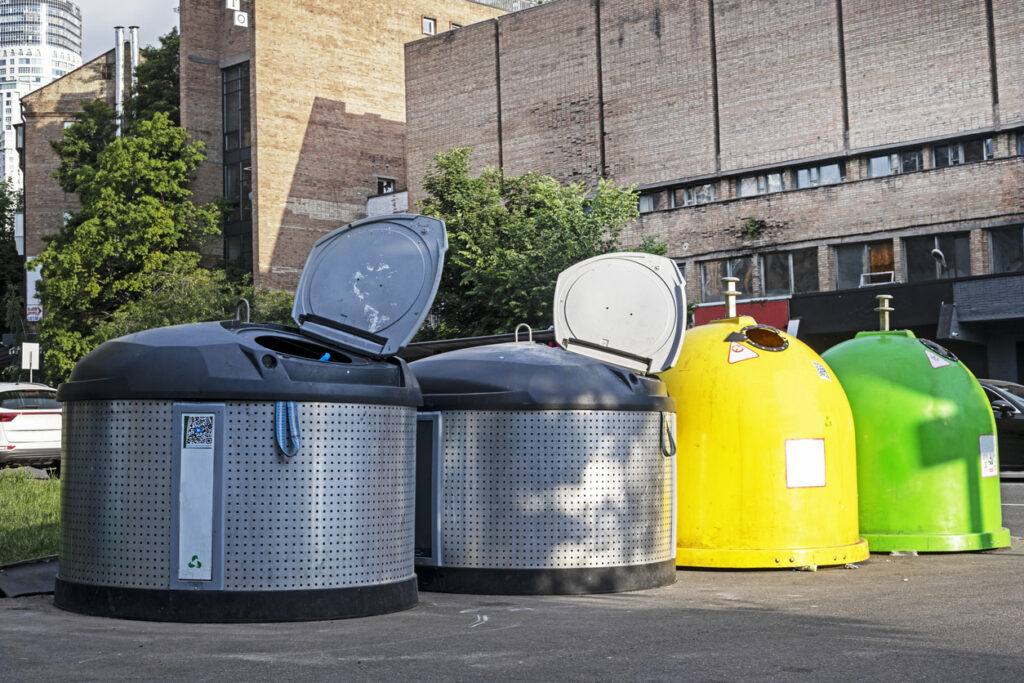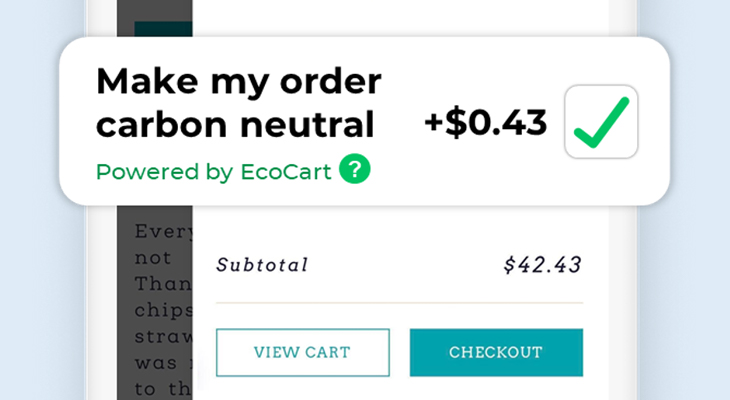By enacting sustainability initiatives as part of your business strategy, you do your part to help the planet and make your company attractive to customers and investors.
Setting up a sustainability strategy isn’t straightforward. But, you don’t have to do it alone. Here’s our guide to environmental sustainability in business and how to set sustainability goals.
We’ll also include some sustainability examples and where you can find help in your corporate sustainability initiatives.
What Is Sustainability In Business?
Sustainability in business is when business is conducted in a manner that’s environmentally and socially responsible. Within ecommerce, this means minimizing your CO2 emissions, especially associated with shipping and transport, utilizing eco-friendly packaging, limiting energy use, and more.
Sustainable business practices can reduce a business’s carbon footprint in day-to-day activities while sustainability programs take a deeper approach to making the business more sustainable. A comprehensive sustainability program begins with a thorough review of the business, which informs which kinds of sustainability initiatives your business will create.
How To Set Your Sustainability Goals
To develop effective sustainability initiatives in the workplace, you must first set goals. These targets must be clear, actionable, and quantifiable. It’s not enough to say, “We would like to have a smaller plastic footprint by next year.”
Setting explicit goals will help you achieve your corporate sustainability initiatives and ensure you avoid greenwashing.
Data-driven, science-backed methodology shows your customers and investors that your business sustainability initiatives are genuine, and if there is any doubt, you can turn to the data to prove your efforts.
Here are some steps to follow when seeking corporate sustainability for business.
- Measure your current impact. You can’t set goals without a leaping-off point. This needs to be thorough and detailed, so while you can conduct an internal audit yourself, it’s recommended that you hire a third party that uses an established ESG framework to provide a complete report. This will likely include a sustainability scorecard, which evaluates your business sustainability KPIs.
- Incorporate your goals into your business model. To be truly sustainable, you need to make your corporate environmental sustainability a key part of your operations. While adding recycling bins to the breakroom isn’t a bad thing, it’s surface level. You must make changes across all areas of operation, such as decarbonizing your supply chains, pollution prevention, and using recycled materials in your products and packaging.
- Incorporate both small and big changes. While a sustainability initiative should go further than replacing single-use cups at the water cooler with reusable water bottles, small actions such as these still help the planet. As you switch to sustainable suppliers and redesign your products to include recycled materials, don’t forget the little things.
- Collect data and constantly analyze your efforts. Effective corporate environmental sustainability initiatives need to be objective and quantifiable. This means choosing science-backed sustainability goals that are constantly measured and analyzed. Collect data on each sustainability initiative, and make sure that you are on the right track. If you are falling short of your larger targets, reassess your approach, and make necessary adjustments to get back on track. Take a look at our guide to sustainability KPIs to get started.
- Pursue green certifications for business. Getting a green business certification knocks out two birds with one stone: you’ll improve your impression to customers and by gaining the green certification, you’ll have made changes to be more sustainable. Keep in mind, however, that there is no finish line when it comes to environmental sustainability initiatives. Even after you earn a green business certification, strategize ways to do more.
- Go above and beyond. No matter how thorough our corporate sustainability initiatives are, we can always do more to minimize our impact. Once you reach your sustainability goals, reassess your impact, and develop new goals to achieve. This may mean reaching into your supply chains and helping them achieve their sustainability goals, too. Becoming climate positive helps us all reach our global emissions goals.
Before we get into the sustainability initiatives, take our quick quiz to find out where your business could improve and which initiatives will have the greatest impact.
50 Sustainability Initiatives To Get Started
Let’s take a look at 50 sustainability initiatives that might be a good fit for your business. Keep in mind that you can have multiple running simultaneously!
- Green Energy Transition: Switch to renewable energy sources like solar or wind for your operations.
- Eco-Friendly Packaging: Use biodegradable or recyclable packaging materials.
- Waste Reduction: Implement a zero-waste policy in the workplace.
- Water Conservation: Install water-saving fixtures and appliances.
- Sustainable Supply Chain: Partner with suppliers who have green practices.
- Employee Green Training: Educate employees about sustainable practices.
- Carbon Offsetting: Invest in projects that offset your carbon emissions.
- Green Transportation: Encourage carpooling, biking, or use of electric vehicles.
- Eco-Friendly Products: Offer products made from sustainable materials.
- Local Sourcing: Source materials and products locally to reduce transportation emissions.
- Digital Operations: Reduce paper usage by digitizing operations.
- Recycling Program: Set up a comprehensive recycling program.
- Composting: Implement composting for organic waste.
- Energy-Efficient Appliances: Use energy-star rated appliances.
- Sustainable Investments: Invest in green bonds or sustainable projects.
- Green Building Design: Incorporate green architecture and design.
- Eco-Friendly Events: Host or sponsor green community events.
- Sustainable Marketing: Use digital marketing over traditional paper-based methods.
- Eco-Friendly Gifts: Offer sustainable corporate gifts to clients and employees.
- Green Web Hosting: Use a green web hosting provider.
- Sustainable Uniforms: Provide employees with uniforms made from sustainable materials.
- Reduce Single-Use Plastics: Eliminate or reduce single-use plastics in operations.
- Eco-Friendly Cleaning: Use green cleaning products.
- Sustainable Landscaping: Use native plants and eco-friendly landscaping techniques.
- Green Procurement: Prioritize purchasing from green suppliers.
- Eco-Friendly Travel: Encourage video conferencing over travel.
- Green Partnerships: Collaborate with eco-friendly brands or NGOs.
- Sustainable Product Design: Design products with a longer lifecycle.
- Eco-Friendly Rewards: Offer green rewards or incentives to employees.
- Sustainable Office Supplies: Use recycled or eco-friendly office supplies.
- Green Renovations: Use sustainable materials for office renovations.
- Eco-Friendly Breakroom: Stock the breakroom with sustainable products.
- Green Challenges: Host sustainability challenges or competitions.
- Eco-Friendly Vendors: Use vendors who prioritize sustainability.
- Sustainable Transportation: Offer a company shuttle or support public transit.
- Green Certifications: Obtain sustainability certifications for your business.
- Eco-Friendly Storage: Use sustainable storage solutions.
- Sustainable Product Returns: Offer a green return policy.
- Green Employee Benefits: Offer benefits like a bike-to-work scheme.
- Sustainable Workspaces: Design workspaces with sustainability in mind.
- Eco-Friendly Promotions: Promote green products or services.
- Sustainable Product Disposal: Offer eco-friendly disposal methods for products.
- Green Technology: Invest in sustainable tech solutions.
- Eco-Friendly Shipping: Use sustainable shipping methods or materials.
- Sustainable Stakeholder Engagement: Engage stakeholders in sustainability discussions.
- Green Research & Development: Invest in R&D for sustainable solutions.
- Sustainable Customer Engagement: Educate customers about green practices.
- Eco-Friendly Loyalty Programs: Offer green rewards to loyal customers.
- Sustainable Reporting: Regularly report on sustainability progress.
- Green Community Engagement: Engage in community green projects or initiatives.
These initiatives can be tailored to fit the specific needs and capabilities of different businesses, but they should get your creative juices flowing. Incorporating them can help businesses not only reduce their environmental impact but also appeal to a growing base of eco-conscious consumers.
Now let’s see how these five businesses designed their initiatives to help them meet their sustainability goals.
Examine.
5 Examples Of Corporate Sustainability Initiatives
To set a sustainability initiative, you must first visualize what sustainability practices look like. Here are some environmental sustainability initiatives examples.
1. Zero Emissions

Net zero emissions is a global goal as set forth by the Paris Agreement. Carbon emissions significantly contribute to global warming. Reducing these emissions, ideally to zero, helps combat climate change.
Making this the primary goal for your corporate sustainability initiatives is a good starting point if you’re just starting to take steps to becoming more sustainable.
Here are some ways to reduce your carbon footprint:
- Switch to a green web host.
- Reduce plastic packaging.
- Offer carbon-neutral shipping through carbon offset projects.
- Use third-party warehouses to reduce shipping distances.
Real-world example
One of our customers, Nomad Goods, offers a fantastic example of corporate sustainability goals. It has achieved carbon neutrality by reducing its emissions in all areas of operation—including its supply chains, manufacturing, and deliveries—and offsetting the emissions that it can’t eliminate. Every year, it analyzes its efforts to ensure that it remains on track.
2. Conserve Resources

Resource conservation is the practice of using resources in an efficient and ethical way. This may include reusing materials instead of sourcing virgin materials, investing in fair trade sources, and reducing material and resource waste.
Here are some other ways you can include resource conservation in your corporate sustainability initiatives:
- Use energy efficient light bulbs.
- Redesign your products to use recycled or upcycled materials.
- Minimize packaging.
- Carefully choose suppliers that engage in ethical practices.
Real-world example
Another customer, KAIBAE, has made resource conservation a tenet of its operations by partnering with harvesting communities in Ghana, Colombia, Zanzibar, and Uganda and wild-harvesting the plants it puts in its products. This ensures that workers are treated fairly and that the ingredients are sourced in a responsible manner.
3. Responsible Waste Management

Responsible waste management is an important sustainability initiative in e-commerce. By managing your waste responsibly, your company can reduce litter, keep waste out of landfills, and contribute to the circular economy.
Here are some ways that your company can responsibly manage its waste:
- Install recycling bins for your employees to use.
- Invest in eco-friendly packaging that’s both recycled and recyclable.
- Use suppliers that also seek to minimize their waste.
- Take responsibility for your plastic footprint by investing in plastic offset projects.
- Eco-friendly clothing brands can include a recycled clothing program to reduce end-of-life waste.
Real-world example
Tribe Kelley is an apparel line that seeks to minimize waste within fashion. Its efforts are seen at every level of operation. It’s careful not to over-produce its products, launching infrequently to minimize waste. Additionally, it produces high-quality clothing that can enjoy numerous wears, and it stays away from micro-trends, opting for stylish designs that will remain stylish for some time to come.
4. Alternative/Renewable Energy

You can further minimize your carbon footprint by reducing your reliance on fossil fuels. While switching to renewable energy sources may incur upfront costs, it will save you money in the long run.
Here are some ways to switch to clean energy.
- Install solar panels on your buildings.
- Help your supply chains make the switch to renewable energy, too.
- Use fully electric or hybrid vehicles that use fewer fossil fuels.
Real-world example
In an effort to become climate positive, Apple has invested in its manufacturers and suppliers to help them make the switch to clean energy. In this way, it has gone beyond its own goals to expand sustainable practices to other businesses, too.
5. Responsible Packaging

Packaging waste is one of ecommerce’s biggest areas of impact, so responsible packaging should be a primary focus of your corporate sustainability initiatives. It can be minimized by choosing eco-friendly packaging options that make use of recycled materials and can be reused.
Here are some things to look for in eco-friendly packaging:
- It uses post-consumer materials that would have otherwise ended up in a landfill.
- It has double seals so that the same bag can be used if a product must be returned.
- It’s minimal; don’t use more packaging than you need.
Real-world example
Wild Way is a natural food company that keeps plastic in use by creating packaging that’s made of post-consumer recycled plastic. By eliminating single-use plastics, it improves its corporate sustainability, contributes to the circular economy and minimizes mismanaged plastic waste.
How To Manage Your Business Sustainability Initiatives
Once you’ve formulated your sustainability goals, you must develop ways to achieve them. Here are some methods depending on the size and needs of your business.
Manually select the most sustainable business options
Smaller businesses with fewer resources can manually choose the areas where they can reduce their environmental impact. These types of businesses usually have fewer moving parts, so it’s much easier to identify ways to enact positive change. These will include things like investing in environmentally sound recycling methods, switching to renewable energy sources, investing in pollution prevention, choosing environmental suppliers, and switching to a green web host.
Use sustainability consulting
Larger companies that carry a bigger impact with more moving parts will benefit from hiring a sustainability consultant. An expert will be able to analyze your impact using an established sustainability framework, and they’ll provide a thorough plan to minimize your company’s footprint in ways that you might not have even imagined.
Climate consultants will paint a picture of your current impact, identify ways that you can minimize your impact, and even help you develop goals and strategies to reach your larger sustainability targets. It’s one of the best ways for mid-size to big businesses to ensure their sustainability strategies are on point.
Automate sustainable shopping experiences with EcoCart
Businesses looking to reduce their carbon footprint can benefit from the automated offerings offered through EcoCart. We are more than an eco-friendly app. We are a sustainability partner that will help you minimize your CO2 emissions through carbon offsetting for business, sustainable shopping carts, carbon emission tracking, and more.
Here’s what we offer:
- Verified carbon offsetting projects that neutralize greenhouse gas emissions associated with shipping.
- Resources to help you tell your sustainability story and share your progress with your customers.
- A carbon dashboard to help you track your progress and brainstorm ways to do more.
- A real partner in your journey to carbon neutrality.

How To Measure The Success Of Sustainability Initiatives
Sustainable brands achieve their goals through sustainability KPIs to track and measure success. To give you an idea of what this looks like, here are some key performance indicators that you can set for your business.
- Energy consumption: Reducing your energy consumption can help lower your carbon footprint, lower business costs, and reduce waste. You can minimize your energy consumption by installing motion sensor lights in the workplace, switching to renewable energy when you can, and putting in policies to require employees to shut down their computers and work spaces at night.
- Greenhouse gas emissions: Carbon emissions are another area where ecommerce companies see a major impact, and therefore, an important area of measurement. You can reduce your carbon footprint by discouraging overnight shipping, limiting shipping distances, and investing in carbon offsetting projects.
- Recycling rates: By measuring your recycling rates, you can ensure that you are contributing to the circular economy and keeping usable materials out of landfills. You can improve your recycling rates by providing recycling receptacles to your employees, encouraging your customers to recycle their packaging, and opting for post-consumer recycled materials over single-use options.
- Water use: Perhaps surprisingly, water use carries a fairly significant impact within ecommerce. For example, data centers are cooled using water, and this can be incredibly problematic, especially as many data centers appear in areas that suffer from drought. You can minimize your water use by carefully selecting your web host and ensuring that their cooling systems are ethically sourced.
Learn more about setting sustainability KPIs here.
Conclusion
Sustainable business growth requires thorough and thoughtful goal-setting to see effective results. Ecommerce companies need to go above and beyond, using science-backed methodology to truly make a difference and align with their customers.
If you’re serious about reaching your sustainability goals, then reach out to our team for a demo today.



